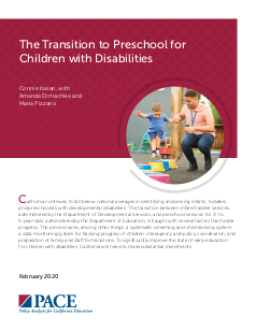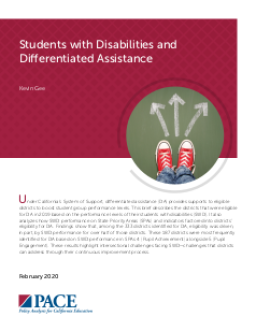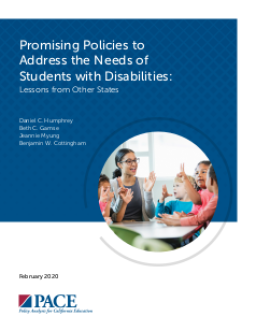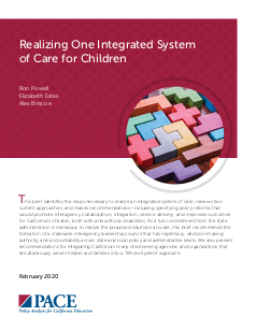A Summary of the PACE Policy Research Panel
Published
Summary
Over 725,000 California K-12 students received special education services in 2018-19, but the system is not always equipped to serve them. Early screening, identification, and intervention, as well as better transitions, educator support, and mental/physical health services, need improvement. A Multi-Tiered System of Supports (MTSS) framework in schools could address SWDs' needs, but it requires additional resources and policy support to improve educator capacity and collaboration between agencies while systematizing data on SWDs.
Published
Summary
California is failing to identify and serve infants, toddlers, and preschoolers with developmental disabilities compared to national averages. The transition from infant/toddler services to preschool services is hindered by various factors such as the lack of a systematic screening and child tracking system, interagency coordination, and family/staff preparation for transitions. Significant investments are required to improve the state of early education for children with disabilities in California.
Published
Summary
This brief discusses how California's System of Support uses differentiated assistance (DA) to provide support to districts and boost student group performance levels. It analyzes the districts eligible for DA in 2019 based on their students with disabilities' (SWD) performance on State Priority Areas (SPAs) and indicators. The findings show that over half of the 333 eligible districts were driven by SWD performance in SPAs 4 (Pupil Achievement) and 5 (Pupil Engagement), highlighting intersectional challenges facing SWD that districts can address through their continuous improvement process.
Lessons from Other States
Published
Summary
This report discusses the challenges California faces in improving educational outcomes for students with disabilities (SWDs) and how inclusion in general education classrooms has positive benefits. It examines strategies used by Massachusetts, New Jersey, and Florida to improve inclusion rates and makes four recommendations for California, including implementing a data system, targeted support for districts with poor inclusion rates, and an inclusion tool for schools and districts to assess their practices.
Published
Summary
This brief outlines the necessary steps to integrate care systems and improve outcomes for California's children. It suggests forming a statewide interagency leadership council and recommends policy reforms to promote collaboration, integration, and service delivery. The goal is to create a "Whole System" approach that integrates child-serving agencies and organizations. A full commitment from the state administration is needed to achieve these solutions at scale.




